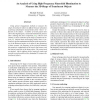Free Online Productivity Tools
i2Speak
i2Symbol
i2OCR
iTex2Img
iWeb2Print
iWeb2Shot
i2Type
iPdf2Split
iPdf2Merge
i2Bopomofo
i2Arabic
i2Style
i2Image
i2PDF
iLatex2Rtf
Sci2ools
121
click to vote
CVPR
2011
IEEE
2011
IEEE
An Analysis of Using High-Frequency Sinusoidal Illumination to Measure the 3D Shape of Translucent Objects
Using optical triangulation methods to measure the shape of translucent objects is difficult because subsurface scattering contaminates measurements of the “direct” reflection at the surface. A number of recent papers have shown that high-frequency sinusoidal illumination patterns allow isolating this direct component [16], which in turn enables accurate estimation of the shape of translucent objects [4]. Despite these encouraging results, there is currently no rigorous mathematical analysis of the expected error in the measured surface as it relates to the parameters of these systems: the frequency of the projected sinusoid, the geometric configuration of the source and camera, and the optical properties of the target object. We present such an analysis, which confirms earlier empirical results and provides a much needed tool for designing 3D scanners for translucent objects.
Computer Vision | CVPR 2011 | Optical Triangulation Methods | Rigorous Mathematical Analysis | Translucent Objects |
| Added | 05 Apr 2011 |
| Updated | 29 Apr 2011 |
| Type | Journal |
| Year | 2011 |
| Where | CVPR |
| Authors | Michael Holroyd, Jason Lawrence |
Comments (0)

